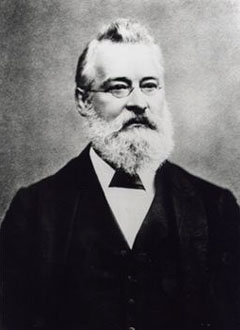- Four element theory: earth, air, fire & water

John Newlands in 1864

- The known elements (>60) were arranged in order of atomic weights and observed similarities between the first and ninth elements, the second and tenth elements etc.
- He proposed the 'Law of Octaves'.
- Also he assigned Hydrogen an arbitary mass of 1.

- First produced a table based on atomic weights but arranged 'periodically' with elements with similar properties under each other
- Gaps were left for elements that were unknown at that time and their properties predicted (the elements were gallium, scandium and germanium)
- The order of elements was re-arranged if their properties dictated it, eg, tellerium is heavier than iodine but comes before it in the Periodic Table
- Mendeleev's Periodic Table was important because it enabled the properties of elements to be predicted by means of the 'periodic law': properties of the elements vary periodically with their atomic weights.
Modern Periodic Table
Our modern day periodic table is expanded beyond Mendeleev's initial 63 elements. Most of the current periodic tables include 108 or 109 elements.

Groups
- The modern periodic table of the elements contains 18 groups, or vertical columns.
- Elements in a group have similar chemical and physical properties because they have the same number of outer electrons.
- Elements in a group are like members of a family--each is different, but all are related by common characteristics.
- To avoid confusion, the Roman numerals and letters designating groups will eventually be replaced by the numerals from one to eighteen.
Periods
- Each of the table's horizontal rows is called a period.
- Along a period, a gradual change in chemical properties occursfrom one element to another.
- Changes in the properties occur because the number of protons and electrons increases from left to right across a period or row.
- The increase in number of electrons is important because the outer electrons determine the element's chemical properties.

- They are usually shiny, very dense, and only melt at high temperatures.
- Their shape can be easily changed into thin wires or sheets without breaking.
- Metals will corrode, gradually wearing away, like rusting iron.
- Heat and electricity travel easily through metals, which is why it is not wise to stand next to a flagpole during a thunderstorm!
Nonmetals
- On the right side of the periodic table, are very different from metals.
- Their surface is dull and they don’t conduct heat and electricity.
- As compared to metals, they have low density and will melt at low temperatures.
- The shape of nonmetals cannot be changed easily because they are brittle and will break.
Metalloids
- Elements that have properties of both metals and nonmetals.
- They can be shiny or dull and their shape is easily changed.
- Electricity and heat can travel through metalloids but not as easily as they travel through metals.



No comments:
Post a Comment